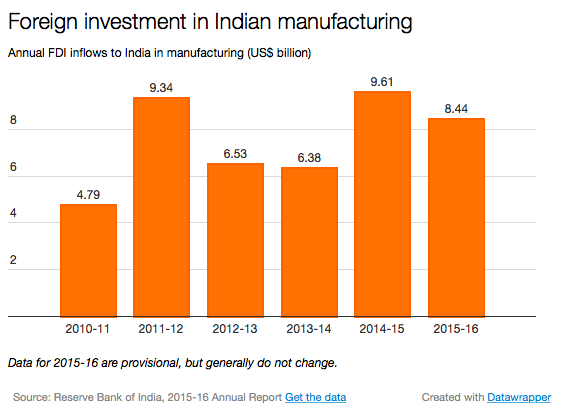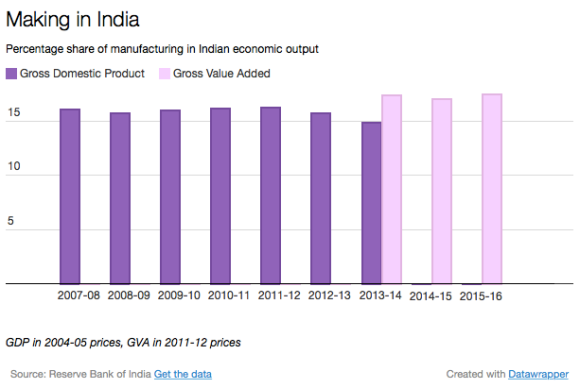
The ‘Make In India’ campaign aims to make India a global manufacturing hub, but according to recent RBI data, both FDI in manufacturing and the percentage of FDI flowing to manufacturing declined in 2015-16.

The main aim of Make in India initiative is to increase the share of manufacturing in India’s GDP to 25% by 2022. Credit: PTI
The logic behind the government’s Make in India initiative is clear. As Prime Minister Narendra Modi stated in his speech at the launch of “Make in India Week” in Mumbai on February 13, 2016:
We launched the Make in India campaign to create employment and self-employment opportunities for our youth. We are working aggressively towards making India a global manufacturing hub. We want the share of manufacturing in our GDP to go up to 25% in the near future.
Advertisement
And the way to do this, according to Make in India, is to increase the share of manufacturing in India’s GDP to 25% by 2022, which is expected to generate approximately 100 million jobs for Indian workers.
So how are we doing so far? If you believe the headlines, pretty well. Responding to the lifting of foreign direct investment (FDI) caps in several sectors, efforts to improve the ease of doing business and of course Prime Minister Modi’s frenetic wooing of investment in foreign travels, gross FDI flows to India jumped 27% to $45 billion in 2015-16, an all-time high. Even the Finance Ministry’s usually measured Economic Survey 2015-16 touted the FDI increase as a success for Make in India. With our social media feeds full of stories about this or that investment, clearly the #MakeInIndia lion is roaring.
But the closer you get to the lion, the more the roar sounds like a meow.
Consider the most recent FDI data from the Reserve Bank of India (RBI), broken up by sector, since Make in India specifically concerns manufacturing. After an encouraging jump to a record $9.6 billion in 2014-15, FDI in manufacturing actually fell to $8.4 billion in 2015-16 (below the $9.3 billion it had reached in 2011-12).

Note that these numbers cover inflows approved by the RBI and other agencies and exclude share purchases, reinvested earnings and so on. This pattern is consistent with data from the Department of Industrial Policy and Promotion, analysed here.
Furthermore, the percentage of FDI flowing to manufacturing, which has been in the range of 35-40% for the past four years, dropped to 23% in 2015-16. Rather than manufacturing, services – think e-commerce providers like Amazon, Snapdeal and Flipkart, ride-sharing services like Uber and Ola – seem to be drawing a greater share of the investment.

What about the broader economy? After all, Make in India’s main objective is to raise the share of manufacturing in the economy as a means of generating jobs.

Sadly, no meaningful change yet: the share of manufacturing has been flat for the past decade, with a slight downward trend.
Here’s the rub: there is no doubt that building infrastructure, liberalising land and labour laws and improving the ease of doing business is difficult and time consuming and will take time to play out. But the Modi government needs to convince voters that change is happening and fast.
Which is the genius of the Make in India campaign – it is essentially a branding exercise under which the government claims credit for pretty much everything. Every factory inaugurated, every defence deal signed, every shovel stuck into the ground will now be accompanied by the hashtag #MakeInIndia, even if the percentage of GDP arising from manufacturing stays exactly where it has been for the past decade.
Consider this recent tweet from the official Make in India handle:
From Tejas to BrahMos, #MakeInIndia takes off with much gusto in the aerospace sector. https://t.co/4ogAPLLuEl pic.twitter.com/ffKYV0fNy9
— Make in India (@makeinindia) July 15, 2016
Advertisement
The Tejas is an Indian fighter plane that has been in development for more than two decades and first flew in 2001, but let’s label it #MakeInIndia. The BrahMos is a modified Russian cruise missile with Indian software that entered service with the Indian Navy in 2005, but, hey, why not #MakeInIndia.
This article originally appeared on Chaunauti. Read the original article.





